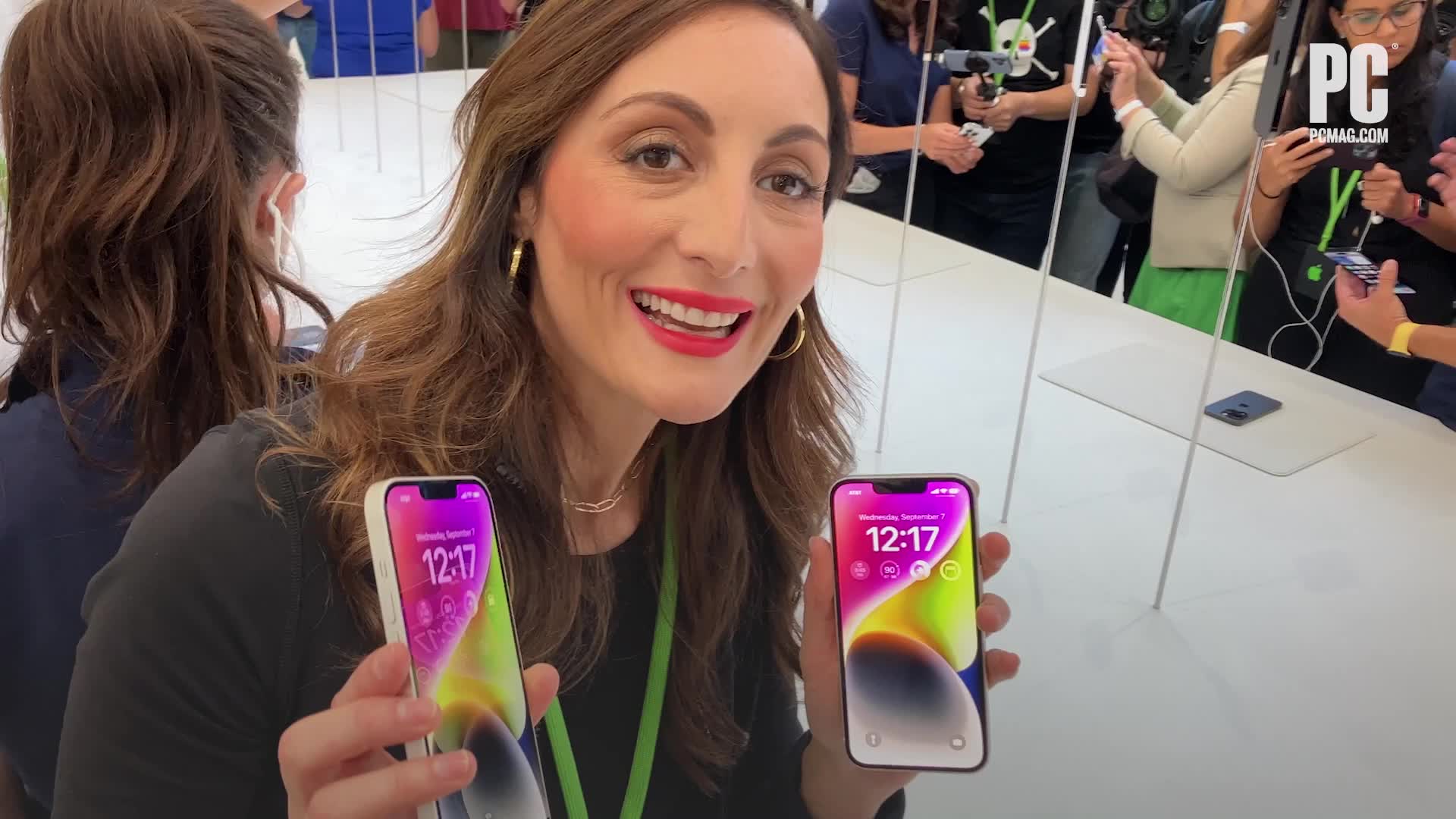As expected, Apple today unveiled the iPhone 14, and the event's "far out" tagline was indeed a reference to satellite connection.
The iPhone 14 lineup includes the usual suspects: The iPhone 14, iPhone 14 Plus, iPhone 14 Pro, and iPhone 14 Pro Max. Expect processor bumps and better cameras, as well as a few bells and whistles, like an always-on display for the Pro versions, which also drop the notch for something Apple's calling Dynamic Island.
Also of note: All the iPhone 14 models ditch physical SIMs and SIM trays in favor of eSIM (which has annoyed a number of international travelers.)
iPhone 14 Pro and Pro Max

There were rumors that Apple would swap the notch for a pin-hole camera on the iPhone 14, and while it's not that tiny, the not-quite-a-notch on the Pro phones is smaller than those on the Phone 14 and 14 Plus, and it moves to accomodate certain apps and services.
On the 14 Pro, the TrueDepth camera takes up less space, so the pill-shaped Dynamic Island area up top will expand and condense to show off alerts, notifications, and activities.
"Ongoing background activities like Maps, Music, or a timer remain visible and interactive, and third-party apps in iOS 16 that provide information like sports scores and ride-sharing with Live Activities can take advantage of the Dynamic Island," Apple says.
The 14 Pro and Pro Max run Apple's A16 Bionic chip, which Apple says should support "all-day battery life" (we'll have to put that to the test in PC Labs). There are two high-performance cores and four high-efficiency cores, plus an accelerated 5-core GPU and a new 16-core Neural Engine capable of nearly 17 trillion operations per second.

For photography enthusiasts, Apple promises a "giant leap for mid- to low-light performance" on the Pro versions. There's a 48MP Main camera on the Pro line for the first time with "a quad-pixel sensor that adapts to the photo being captured, and features second-generation sensor-shift optical image stabilization."
This should allow for a 2x Telephoto option that produces full-resolution photos and 4K videos with no digital zoom, according to Apple, which says a new machine learning model will also allow the iPhone to shoot ProRAW at 48MP with great detail.
The iPhone 14 Pro and Pro Max feature 6.1- and 6.7-inch displays, respectively. They will be available in deep purple, silver, gold, and space black in 128GB, 256GB, 512GB, and 1TB storage capacities. Pre-orders begin Sept. 9 at 5 a.m. PT; they'll be in stores starting Sept. 16.
The 14 Pro starts at $999, while the Pro Max starts at $1,099.
For more, check out the hands-on video below:

iPhone 14 and iPhone 14 Plus

If you want to upgrade for less, the iPhone 14 and 14 Plus also come in 6.1- and 6.7-inch sizes, but they're not quite as supercharged as their Pro counterparts.
Both phones run the A15 Bionic with a 6-Core CPU and 5-core GPU and feature a 12MP Main camera. The notch remains.
The Phone 14 and iPhone 14 Plus will be available in midnight, blue, starlight, purple, and (Product)Red in 128GB, 256GB, and 512GB storage capacities. The iPhone 14 starts at $799, while the 14 Plus starts at $899.
Pre-orders begin at 5 a.m. PT on Sept. 9 for both phones; the iPhone 14 arrives on Sept. 16 but the iPhone 14 Plus doesn't launch until Oct. 7. For more, check out our hands on with the iPhone 14 lineup from Apple Park and the video below:

Satellite-Based Emergency SOS

Ideally, not that many iPhone 14 buyers will use the phone's satellite connectivity that much. Emergency SOS will use the iPhone 14's antennas to connect directly to a satellite when necessary, allowing people who need help to contact emergency services from remote locales.
But as Apple notes, satellites are "moving targets with low bandwidth" so you'll need to be in an open space with a clear line to the satellite in question. Your phone will tell you which direction to turn to connect.
It also only supports text messages, which could take between 15 seconds to a few minutes to send each one. As a result, Emergency SOS will display a multiple choice of emergencies when you activate it to avoid unhelpful or auto-correct-laden messages clogging up the network.
If your message hits a satellite ground station that can accept text messages, it'll be sent on its way. Otherwise, Apple says it'll have "centers staffed by Apple‑trained specialists who can call for help on the user’s behalf."
For less dire situations, however, Apple says Emergency SOS will let people manually share their location over satellite with the Find My app when they're in a cellular dead zone.
Initially, Emergency SOS will roll out in November in the US and Canada across the iPhone 14 lineup and will be free for the first two years. Apple didn't say how much it'll cost after that.
Crash Detection
Another feature Apple says it hopes you never need is Crash Detection. It'll work on the entire iPhone 14 lineup, as well as the new Apple Watches. A dual-core accelerometer in the phones—which can detect G-force measurements of up to 256Gs—and a new high dynamic range gyroscope will be able to tell if you've been in a serious car crash and automatically dial for help.

Like What You're Reading?
Sign up for Fully Mobilized newsletter to get our top mobile tech stories delivered right to your inbox.
This newsletter may contain advertising, deals, or affiliate links. Subscribing to a newsletter indicates your consent to our Terms of Use and Privacy Policy. You may unsubscribe from the newsletters at any time.
Thanks for signing up!
Your subscription has been confirmed. Keep an eye on your inbox!
Sign up for other newsletters



 iPhone 14 Pro
(Credit: Apple)
iPhone 14 Pro
(Credit: Apple)











